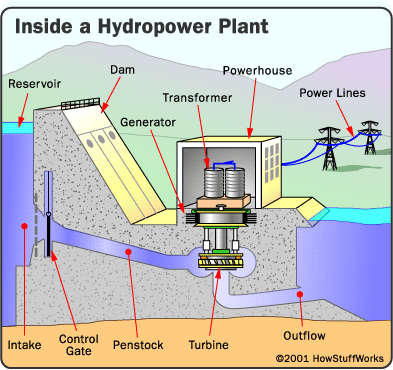Renewable energy (sources) or RES capture their energy from existing flows of energy, from on-going natural processes, such as sunshine, wind, wave power, flowing water (hydropower), biological processes such as anaerobic digestion, and geothermal heat flow.
The most common definition is that renewable energy is from an energy resource that is replaced by a natural process at a rate that is equal to or faster than the rate at which that resource is being consumed. Renewable energy is a subset of sustainable energy.
Most renewable forms of energy, other than geothermal and tidal power, ultimately derive from solar energy. Energy from biomass derives from plant material produced by photosynthesis using the power of the sun. Wind energy derives from winds, which are generated by the sun’s uneven heating of the atmosphere. Hydropower depends on rain which again depends on sunlight’s power to evaporate water.
Even fossil fuels derive from solar energy, as fossil fuel originates from plant material. However, while theoretically renewable on a very long time-scale, fossil fuels are exploited at rates that may deplete these resources in the near future, and are therefore not considered renewable.
Renewable energy resources may be used directly, or used to create other more convenient forms of energy. Examples of direct use are solar ovens, geothermal heating, and water- and windmills. Examples of indirect use which require energy harvesting are electricity generation through wind turbines or photovoltaic cells (PV cells), or production of fuels such as biogas from anaerobic digestion or ethanol from biomass.
Renewable energy development is concerned with the use of renewable energy sources by humans. Modern interest in renewable energy development is linked to concerns about exhaustion of fossil fuels and environmental, social and political risks of extensive use of fossil fuels and nuclear energy.
Hydroelectric Power
Hydropower plants confine the energy of falling water to generate electricity. A turbine converts the kinetic energy of falling water into mechanical energy. Then a generator converts the mechanical energy from the turbine into electrical energy.
Hydroplants vary in size from “micro-hydros” that power only a few homes to giant dams like Hoover Dam that supply electricity to millions of people, across several regions.
The following diagram adequately depicts how a hydropower plant works:

Most conventional hydroelectric plants include four major components :
- Dam: Raises the water level of the river to create falling water. Also controls the flow of water. The reservoir that is formed is, in effect, stored energy.
- Turbine: The force of falling water pushing against the turbine’s blades causes the turbine to spin. A water turbine is much like a windmill, except the energy is provided by falling water instead of wind. The turbine converts the kinetic energy of falling water into mechanical energy.
- Generator: Connected to the turbine by shafts and possibly gears so when the turbine spins it causes the generator to spin also. Converts the mechanical energy from the turbine into electric energy. Generators in hydropower plants work just like the generators in other types of power plants.
- Transmission lines: Conduct electricity from the hydropower plant to homes and business.
Wind Power
Wind power is produced by using wind generators to harness the kinetic energy of wind. It is gaining worldwide popularity as a large scale energy source, although it still only provides less than one percent of global energy consumption.
Fuel Cells
A fuel cell is a device that generates electricity by a chemical reaction. Every fuel cell has two electrodes, one positive and one negative, called, respectively, the anode and cathode. The reactions that produce electricity take place at the electrodes.
Photo Voltaic Cells
A photovoltaic cell (PV cell) is a specialized semiconductor diode that converts visible light into direct current (DC). Some PV cells can also convert infrared (IR) or ultraviolet (UV) radiation into DC electricity. Photovoltaic cells are an integral part of solar-electric energy systems, which are becoming increasingly important as alternative sources of utility power.
The first PV cells were made of silicon combined, or doped, with other elements to affect the behavior of electrons or holes (electron absences within atoms). Other materials, such as copper indium diselenide (CIS), cadmium telluride (CdTe), and gallium arsenide (GaAs), have been developed for use in PV cells. There are two basic types of semiconductor material, called positive (or P type) and negative (or N type). In a PV cell, flat pieces of these materials are placed together, and the physical boundary between them is called the P-N junction. The device is constructed in such a way that the junction can be exposed to visible light, IR, or UV. When such radiation strikes the P-N junction, a voltage difference is produced between the P type and N type materials. Electrodes connected to the semiconductor layers allow current to be drawn from the device.
Large sets of PV cells can be connected together to form solar modules, arrays, or panels. The use of PV cells and batteries for the generation of usable electrical energy is known as photovoltaics. One of the major advantages of photovoltaics is the fact that it is non-polluting, requiring only real estate (and a reasonably sunny climate) in order to function. Another advantage is the fact that solar energy is unlimited. Once a photovoltaic system has been installed, it can provide energy at essentially no cost for years, and with minimal maintenance.

